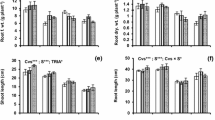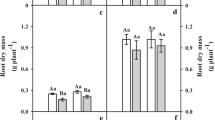Abstract
Plant water status and cellular osmotic adjustments play a key role in the salt tolerance of plants. An experiment was conducted to assess the influence of foliar-applied ascorbic acid (AsA) on the plant water relations, cellular osmotic adjustments, uptake, and accumulation of different ions in the two high yielding maize cultivars (Agaiti-2002 and EV-1098) at early growth stage under salt stress (120 mM NaCl). Salt stress altered growth, water relation attributes, osmolytes accumulation, and decreased the uptake of K+, Ca2+, P, and N, while increased the uptake and accumulation of Na+ in different plant parts (leaf, stem, and root). Exogenous AsA increased the accumulation of AsA in different plant parts, particularly in leaves and roots. Moreover, AsA application resulted in the accumulation of proline and glycinebetaine (GB) in the roots and leaves of both maize cultivars when under salt stress. Foliar application of AsA also increased the uptake of minerals such as K+, Ca2+, P, and N and decreased the uptake and accumulation of Na+ in different plant parts. Taken together, the AsA-induced enhanced accumulation of osmolytes (GB and proline) and AsA increased the K+/Na+ ratio, and more accumulation of beneficial nutrients in the roots and leaves enhanced water uptake from soil and reduced the negative effects of Na+ in the salt-stressed maize plants. The results suggested that foliar-applied AsA either accelerated the tissue-specific translocation of AsA or altered the de novo synthesis of AsA to mitigate the adverse effects of salinity in maize plants.






Similar content being viewed by others
References
Abdelgawad ZA (2014) Improving growth and yield of salt-stressed cowpea plants by exogenous application of ascobin. Life Sci J 11:43–51
Abou-Leila B, Metwally SA, Hussen MM, Leithy SZ (2012) The combined effect of salinity and ascorbic acid on anatomical and physiological aspects of jatropha plants. Aust J Basic Appl Sci 6:533–541
Ali Q, Ashraf M (2011a) Exogenously applied glycinebetaine enhances seed and seed oil quality of maize (Zea mays L.) under water deficit conditions. Environ Exp Bot 71:249–259
Ali Q, Ashraf M (2011b) Induction of drought tolerance in maize (Zea mays L.) due to exogenous application of trehalose: growth, photosynthesis, water relations and oxidative defence mechanism. J Agron Crop Sci 197:258–271
Ali Q, Ashraf M, Anwar F, Al-Qurainy F (2012) Trehalose-induced changes in seed oil composition and antioxidant potential of maize grown under drought stress. J Am Oil Chem Soc 89:1485–1493
Athar HR, Khan A, Ashraf M (2008) Exogenously applied ascorbic acid alleviates salt-induced oxidative stress in wheat. Environ Exp Bot 63:224–231
Athar HR, Khan A, Ashraf M (2009) Inducing salt tolerance in wheat by exogenously applied ascorbic acid through different modes. J Plant Nutr 32:1799–1817
Azzedine F, Gherroucha H, Baka M (2011) Improvement of salt tolerance in durum wheat by ascorbic acid application. J Stress Physiol Biochem 7:27–37
Bates LS, Waldren RP, Teare ID (1973) Rapid determination of free proline for water stress studies. Plant Soil 39:205–207
Barakat H (2003) Interactive effects of salinity and certain vitamins on gene expression and cell division. Int J Agric Biol 3:219–225
Blum A, Munns R, Passioura JB, Turner NC, Sharp RE, Boyer JS, Nguyen HT, Hsiao TC (1996) Letters to the editor: genetically engineered plants resistant to soil drying and salt stress: how to interpret osmotic relations. Plant Physiol 110:1051–1053
Boudsocq M, Laurière C (2005) Osmotic signalling in plants. Multiple pathways mediated by emerging kinase families. Plant Physiol 138:1185–1194
Bremner JM, Keeney DR (1965) Steam distillation methods for determination of ammonium, nitrate and nitrite. Anal Chim Acta 32:485–495
Chen Z, Gallie DR (2004) The ascorbic acid redox state controls guard cell signaling and stomatal movement. Plant Cell 16:1143–1162
Darvishan M, Tohidi-Moghadam HR, Zahedi H (2013) The effects of foliar application of ascorbic acid (vitamin C) on physiological and biochemical changes of corn (Zea mays L.) under irrigation withholding in different growth stages. Maydica 58:195–200
de Lacerda CF, Cambraia J, Oliva MA, Ruiz HA, Prisco JT (2003) Solute accumulation and distribution during shoot and leaf development in two sorghum genotypes under salt stress. Environ Exp Bot 49:107–120
Dolatabadian A, Jouneghani RS (2009) Impact of exogenous ascorbic acid on antioxidant activity and some physiological traits of common bean subjected to salinity stress. Not Bot Horti Agrobo 37:165–172
Ejaz B, Sajid ZA, Aftab F (2012) Effect of exogenous application of ascorbic acid on antioxidant enzyme activities, proline contents, and growth parameters of Saccharum spp. hybrid cv. HSF-240 under salt stress. Turk J Biol 36:630–640
Farouk S (2011) Ascorbic acid and α-tocopherol minimize salt-induced wheat leaf senescence. J Stress Physiol Biochem 7:58–79
Franceschi VR, Tarlyn NM (2002) l-Ascorbic acid is accumulated in source leaf phloem and transported to sink tissues in plants. Plant Physiol 130:649–656
Gallie DR (2012) The role of l-ascorbic acid recycling in responding to environmental stress and in promoting plant growth. J Exp Bot 16:1–11
Gallie DR (2013) l-Ascorbic acid: a multifunctional molecule supporting plant growth and development. Scientifica 1:1–24
Ghrab M, Gargouri K, Bentaher H, Chartzoulakis K, Ayadi M, Mimoun MB, Masmoudi MM, Mechlia NB, Psarras G (2013) Water relations and yield of olive tree (cv. Chemlali) in response to partial root-zone drying (PRD) irrigation technique and salinity under arid climate. Agric Water Manag 123:1–11
Grieve CM, Grattan SR (1983) Rapid assay for determination of water soluble quaternary ammonium compounds. Plant Soil 70:303–307
Hameed A, Gulzar S, Aziz I, Hussain T, Gul B, Khan MA (2015) Effects of salinity and ascorbic acid on growth, water status and antioxidant system in a perennial halophyte. AoB Plants 7:plv004. doi:10.1093/aobpla/plv004
Hoque MA, Banu MNA, Okuma E, Amako K, Nakamura K, Shimoishi Y, Murata Y (2007) Exogenous proline and glycinebetaine increase NaCl-induced ascorbate-glutathione cycle enzyme activities, and proline improves salt tolerance more than glycinebetaine in tobacco Bright Yellow-2 suspension-cultured cells. J Plant Physiol 164:1457–1468
Iqbal M, Ashraf M (2013a) Alleviation of salinity-induced perturbations in ionic and hormonal concentrations in spring wheat through seed preconditioning in synthetic auxins. Acta Physiol Plant 35:1093–1112
Iqbal M, Ashraf M (2013b) Gibberellic acid mediated induction of salt tolerance in wheat plants: growth, ionic partitioning, photosynthesis, yield and hormonal homeostasis. Environ Exp Bot 86:76–85
Iqbal N, Ashraf M, Ashraf MY (2008) Glycinebetaine, an osmolyte of interest to improve water stress tolerance in sunflower (Helianthus annuus L.): water relations and yield. South Afr J Bot 74:274–281
Ivanov BN (2014) Role of ascorbic acid in photosynthesis. Biochem (Moscow) 79:282–289
Malash NM, Flowers TJ, Ragab R (2011) Plant-water relations, growth and productivity of tomato irrigated by different methods with saline and non-saline water. Irrig Drain 60:446–453
MSTAT Development Team (1989) MSTAT user’s guide: a microcomputer program for the design management and analysis of agronomic research experiments. Michigan State University, East Lansing
Mukherjee SP, Choudhuri MA (1983) Implications of water stress-induced changes in the levels of endogenous ascorbic acid and hydrogen peroxide in Vigna seedlings. Physiol Plant 58:166–170
Munns R (2002) Comparative physiology of salt and water stress. Plant Cell Environ 25:239–250
Raza SH, Athar HR, Ashraf M, Hameed A (2007) Glycine betaine-induced modulation of antioxidant enzymes activities and ion accumulation in two wheat cultivars differing in salt tolerance. Environ Exp Bot 3:368–376
Rhodes D, Samaras Y (1994) Genetic control of osmoregulation in plants. In: Strange K (ed) Cellular and molecular physiology of cell, vol regulation. CRC Press, Boca Raton, pp 347–367
Sairam RK, Rao VK, Srivastava GC (2002) Differential response of wheat genotypes to long term salinity stress in relation to oxidative stress, antioxidant activity and osmolyte concentration. Plant Sci 163:1037–1046
Sakamoto A, Murata N (2002) The role of glycine betaine in the protection of plants from stress: clues from transgenic plants. Plant Cell Environ 25:163–171
Shangguan Z, Shao M, Dyckmans J (1999) Interaction of osmotic adjustment and photosynthesis in winter wheat under soil drought. J Plant Physiol 154:753–758
Steel RGD, Torrie JH (1986) Principles and procedures of statistics. McGraw Hill, New York
Suarez DL, Grieve CM (2013) Growth, yield, and ion relations of strawberry in response to irrigation with chloride-dominated waters. J Plant Nutr 36:1963–1981
Tavakkoli E, Fatehi F, Coventry S, Rengasamy P, Mcdonald GK (2011) Additive effects of Na+ and Cl− ions on barley growth under salinity stress. J Exp Bot 62:2189–2203
Venkatesh J, Park SW (2014) Role of l-ascorbate in alleviating abiotic stresses in crop plants. Bot Stud 55:1–19
Verslues EP, Sharp RE (1999) Proline accumulation in maize (Zea mays L.) primary roots at low water potentials. II. Metabolic source of increased proline deposition in the elongation zone. Plant Physiol 119:1349–1360
Viégas RA, da Silveira JAG (1999) Ammonia assimilation and proline accumulation in young cashew plants during long term exposure to NaCl-salinity. Rev Bras Fisiol Veg 11:153–159
Author information
Authors and Affiliations
Corresponding author
Rights and permissions
About this article
Cite this article
Jamil, S., Ali, Q., Iqbal, M. et al. Modulations in plant water relations and tissue-specific osmoregulation by foliar-applied ascorbic acid and the induction of salt tolerance in maize plants. Braz. J. Bot 38, 527–538 (2015). https://doi.org/10.1007/s40415-015-0174-6
Received:
Accepted:
Published:
Issue Date:
DOI: https://doi.org/10.1007/s40415-015-0174-6




